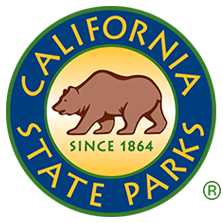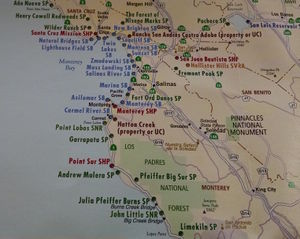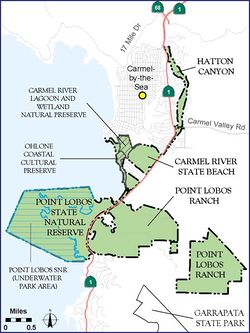California Department of Parks and Recreation (State Parks)
A local agency outlined by the ENVS 560/L Watershed Systems class at CSUMB.
Contents
Background
The California Department of Parks and Recreation is a department under the California Natural Resources Agency. More commonly known as "State Parks", this department manages 280 parks in the state including recreational, historical, and natural areas.
In 1862, the creation of California’s first State Park was pursued by Captain Israel Ward Raymond and California’s U.S. Senator John Conness to preserve natural land and provide public enjoyment. In response, Abraham Lincoln later granted the state Yosemite Valley and Mariposa Big Tree Grove in 1864 which is considered California's first state park[2].
Mission
The mission of State Parks is: “To provide for the health, inspiration and education of the people of California by helping to preserve the state's extraordinary biological diversity, protecting its most valued natural and cultural resources, and creating opportunities for high-quality outdoor recreation.” [3] This mission is addressed in the following ways:
Natural Resources
Through the acquisition of land, State Parks attempts to connect essential habitat, protect sensitive watersheds, and provide a buffer for habitats against urbanization, especially residential or other deleterious land uses.[4]. They also strive to acquire land that helps preserve under-protected habitat types and under-protected ecological regions in California[5].
Cultural Resources
The Cultural Resouces Division has a specific mission is to acquire, conserve, and manage historically relevant artifacts, buildings and lands. This Division also aims to educate the public about California's diverse culture heritage. To achieve this, the division creates cultural heritage publications, protects historic landmarks, manages over one-million museum items, and preserves archaeological resources and sites[6].
Recreational Resources
California’s State Park system provides recreational opportunities to 67 million people annually[7]. Recreational activities include hiking, biking, camping, horseback riding, surfing, swimming, driving off-road vehicles and operating boats. Different types of recreation can come into conflict. In some places, mountain bikers get a bad reputation for riding too fast on trails and endangering hikers or scaring horseback riders. The slower hikers get in the way of the cyclists and cause them to get upset. Balancing all of the different types of recreation is a challenge all parks have to address. State Parks also has to work hard to balance the needs of their natural and cultural resources while simultaneously providing desired recreational opportunities for Californians. Since the founding of the State Parks system, the types of recreation that people expect to find at parks has evolved. More information regarding the future use of State Parks as directed by the Parks Forward Initiative is discussed below under "Issues".
Organization and Governance
The Department of Parks and Recreation is one of the departments within the California Natural Resources Agency, which also includes California Department of Forestry and Fire Protection (CalFire), the California Department of Fish and Wildlife and others. The Secretary of the California Natural Resources Agency is appointed by the governor. Appointment to the position does not require any unique qualifications, other than "officeholders must fulfill the general requirements for holding civil office in California"[8]. As of January 2011, the position has been held by Santa Cruz native John Laird[9]. The Director of the CDPR is also appointed by the governor. In April 2015, Lisa Magat was appointed to the position of director[10].
Under the state umbrella there are 22 districts, 70 sectors and 280 parks. Each park district is headed by a District Superintendent. The District Superintendent is the supervisor for their respective Sector Superintendents. State Parks employs park rangers, or peace officers, to protect resources and visitors along with lifeguards to provide safety on the coast. There are also maintenance staff, natural resources staff, historians, archeologists, and many other job titles. In total, the Parks system employs 2,500 permanent staff and 2,700 seasonal employees[11]. In January 2015, California State Parks announced the establishment of the Transformation Team, lead by a Special Advisor to the Secretary for the Natural Resources Agency, to execute structural and sustainable reforms to the Parks system. This resulted in a recommendation to remove the criteria that all upper-management Superintendents have to come from a Peace Officer (PO) ranking and made it open to all candidates that have the required skills[12].
Commissions
CDPR has four commissions. Commissioners that site on the commissions do not have to have served in a civil office. [13]:
- California State Park and Recreation Commission
- California Boating and Waterways Commission
- California Off-Highway Motor Vehicle Commission
- California State Historical Resources Commission
California State Park and Recreation Commission
Nine commissioners have staggered four-year terms and are appointed by the governor then approved by the senate.
Responsibilities:
- Approval of general plans
- Classifying System units
- Establishing general policies for the guidance of the Director of State Parks in the administration
- Recommending to the Director a comprehensive recreation policy for the state[14]
The Boating and Waterways Commission
Seven commissioners have four-year terms and are appointed by the governor then approved by the senate.
Mandated by the Harbors and Navigation Code (HNC)
Responsibilities:
- Advise and comment on all California Department of Boating and Waterways (DBW) matters within its jurisdiction
- Advise and comment on all boating facilities loans and grants proposed by the division.[15]
California Off-Highway Motor Vehicle Recreation Commission (OHMVR)
Nine members serve on the committee with five chosen by the governor and two are chosen each from the Senate Committee on Rules and the Speaker of the Assembly.
Responsibilities:
- Approval of general plans
- Receives public comments
- Reviews plans for new and expanded recreation areas applying for grant funds[16]
State Historical Resources Commission
Nine members are chosen by the governor then approved by the Senate.
Responsibilities:
- Approves general plans for units of the State Park System
- Classifies units of the State Park System
- Establishes general policies regarding the administration, protection, and development of the state park system
- Recommends to the Director a comprehensive recreation policy for the State of California[17]
Specific land units
Some State Parks land units within the California Central Coast Region include:
- Hearst San Simeon SP 3,406 ac
- Pfeiffer Big Sur SP 1,006 ac
- Forest of Nisene Marks SP 10,223
- Asilomar SB 25 ac
- Point Lobos SNR 1,325 ac
- Pismo SB 1,050 ac
- Morro Bay SP 2,770 ac
- Andrew Molera SP 4,766 ac
- Garrapata SP 2,939 ac
- Wilder Ranch SP 7,000 ac
- Henry Cowell Redwoods SP 4,650 ac
Upcoming/Ongoing Central Coast Park Updates
Monterey District
- Fort Ord Dunes Campground: The new campsite will have 95 campsites with a dump station including accessible camping and hiking, RV camping, car camping, and hike & bike sites. If state and federal permitting all go through, construction should begin in 2019.[6]
- Carmel Area State Parks General Plan: [6] A General Plan is currently (9 April 2018) being developed by California State Parks with input from the public and stakeholders to establish a long-range vision, set of goals, and guidelines for the management of four park properties around the Carmel area. The four state park units included in this plan are: 1) Carmel River State Beach, 2) Point Lobos State Natural Reserve, 3) Point Lobos Ranch (an unclassified park unit), and 4) Hatton Canyon (an unclassified park unit).
- Many Big Sur area state parks are still (10 April 2018) partially closed on the east side of Hwy 1 due to damage from the 2016 Soberanes Fire[18].
Santa Cruz
- Natural Bridges State Park is an over-wintering location for Monarch Butterflies. The blue gum eucalyptus trees that the monarchs like to live in are getting old and dying back, but being a non-native plant species, there has been debate about whether the park should plant more. Three eucalyptus trees were planted in mid-2017, but more active management of the grove is needed to protect it for the monarchs[19].
- A new parking lot is being built for Castle Rock State Park to alleviate parking on the side of Highway 35 (Skyline Blvd). The land for the new parking lot was previously a Christmas tree farm and was purchased by the Sempervirens Fund, a non-profit State Park partner organization, to be the site of the new parking and visitors entrance. The Sempervirens Fund is also paying for the construction, although not all of the money has been raised yet[20].
- Big Basin Redwoods State Park: Ongoing problems with predation of the endangered Marbled Murrelet by corvids (crows and jays) has prompted State Parks to consider removing campsites and picnic facilities from old growth forest areas and potentially relocating a future cabins project. Campers and their associated food and trash increase the local corvid population, which in turn is a threat to the Marbled Murrelets[21].
San Luis Obispo
- Oceano Dunes State Vehicular Recreation Area: This SVRA has had two big problems arise in 2017. The Center for Biological Diversity (CBD) is suing the CDPR for violating the Endangered Species Act (ESA) by allowing vehicles to drive on beaches where Western Snowy Plovers and California Least Terns (both endangered species) live and nest. The South-Central California Steelhead is also listed as being harmed by park activities, due to degradation of the Arryo Grande Creek that lies within the SVRA[22]. Additionally, the county Air Pollution Control District is citing the CDPR as violating dust mitigation regulations at the Ocean Dunes State Vehicular Recreation Area, where ATVs and other vehicles drive on the beaches and create clouds of dust that blow into town[23].
Issues
State Parks has been confronted with a few major issues in recent years. Three of issues and the park's responses are listed below.
Finances
CDPR regularly struggles with the issue of funding for parks. The portion of parks funding that came from the general fund declined from 91 percent in 1980 to 28 percent in 2014[24]. In January 2011, the department's budget was reduced by another $22 million from an already 30% reduced budget from 2000 to 2011[24]. This caused a staffing crisis that compelled Governor Jerry Brown to call for the closure of 70 parks. State Parks Partners stepped up to keep all of the imperiled parks open. Around this same time, it was brought to public awareness that millions of excess dollars were being “hidden” in the park’s revenue [6]. The California State Parks Foundation, other partner organizations, and public outcry led to new legislation that allowed nonprofit organizations that historically helped with the parks to take a more active (and financially supportive) role. A Parks Forward Commission was created to help the department reform financially and remake itself in a time of crisis[24]. The Parks Forward Commission published recommendations in 2015 and a subsequent CDPR Transformation Team was created to put the Commission's suggestions into practice[25].
California Proposition 68, the Parks, Environment, and Water Bond will appear on the California ballot June 5, 2018. This proposed bond contains $2.83 billion for parks that would be disbursed over four years, including $218 million for existing state parks and significant funding for so-called “park-poor” neighborhoods[24].
Changing Demographics
The Parks Forward Commission has published recommendations that work to keep the State Parks system relevant in a time of shifting demographics. In response to these recommendations, parks such as Los Angeles State Historic Park are pushing the boundaries of "conventional" recreation in State Parks. The historic park now offers yoga classes and healthy food workshops in an effort to promote healthy lifestyles in the surrounding neighborhoods and for park users[24]. This is in line with the new recommendations that instructs State Parks to expand its focus from the “traditional” park user to include the state’s growing population of younger people of color[24]. In the Parks Forward report published in February 2015, it is stated that every urban dweller should be within a half-mile walk of a park unit that provides "relevant educational, interpretive, spiritual, cultural, familial, community, and recreational experience”[12]. This directive could slowly change how parks are managed and acquired, perhaps making them more "urban" and more like a city park. Time will tell.
Balancing Recreation and Preservation
The conflict between recreational use and protecting habitat for endangered species is a continuous problem in State Parks. The Central Coast State Parks all have the challenge of maintaining and protecting natural resources, which can include sensitive, threatened and endangered plants and animals, preserving priceless Native American artifacts and remains, and supporting trails that perch on precarious coastlines that are threatened by sea-level rise. Many park rules about staying on trail and not collecting plants or artifacts are in place to protect these resources. Enforcement is a serious challenge, since parks are large in size and often short-staffed. Nowhere is this issue more apparent than in the State Vehicular Recreation Areas (SVRAs) managed by the State Parks. Within these areas, much of the recreating includes driving All Terrain Vehicles (ATVs) off-road, which almost inherently degrades Natural Resources. Parks employees in these areas have the difficult job of balancing the needs of many, different stakeholders with the State Park mission. Locally, the Big Sur Land Trust (BSLT) released a response to the initial meetings and publications for the Carmel Area State Parks General Plan stating that Point Lobos State Natural Reserve was "clearly suffering from overuse" and that State Parks needs to take action to "reduce degradation of the Reserve's resources"[26]. Even being the "crown jewel of the State Parks system" does not make you immune to overuse.
References
- ↑ CA.gov
- ↑ CDPR. “A State Park System is Born”. Retrieved 2 April 2018. https://www.parks.ca.gov/?page_id=940
- ↑ CASP. Main Page. Retrieved 2 April 2018. https://www.parks.ca.gov
- ↑ Natural Resource Acquisition Program. Retrieved 2 April 2018. https://www.parks.ca.gov/?page_id=22305
- ↑ Natural Resources and Sustainable Ecosystems Acquisition Guidelines. Retrieved 10 April 2018. https://www.parks.ca.gov/pages/734/files/acquisition%20guidelines%202008-09%20natural%20resources.pdf
- ↑ 6.0 6.1 6.2 6.3 Cultural Resources Division. Retrieved 3 April 2018. Available from: https://www.parks.ca.gov/?page_id=22491
- ↑ California Department of Parks and Recreation: About Us. Retrieved 7 April 2018. https://www.parks.ca.gov/?page_id=91
- ↑ California Secretary for Natural Resources description. Ballotpedia. Retrieved 10 April 2018. https://ballotpedia.org/California_Secretary_for_Natural_Resources
- ↑ John Laird, California Secretary for Natural Resources official page. Retrieved 7 April 2018. http://resources.ca.gov/secretarys_page/
- ↑ Office of the Governor news release. Governor Brown Announces Appointments. Retrieved 7 April 2018. https://www.gov.ca.gov/2015/04/30/news18941/
- ↑ CDPR Employees. Retrieved 7 April 2018. https://en.wikipedia.org/wiki/California_Department_of_Parks_and_Recreation
- ↑ 12.0 12.1 Parks Forward Initiative Recommendations. Pub Feb 2015. Retrieved 10 April 2018. http://parksforward.com//site/uploads/PFI%20Recommendations_Final_012915%20(00278207xA1C15)%20(1).pdf
- ↑ “California State Park and Recreation Commission” [2 April 2018]. Available from: https://www.parks.ca.gov/commission
- ↑ CDPR. “California State Park and Recreation Commission” [2 April 2018]. Available from: https://www.parks.ca.gov/?page_id=29247
- ↑ CDPR. “California Boating and Waterways Commission” [2 April 2018]. Available from: https://www.parks.ca.gov/?page_id=28835
- ↑ CDPR. “OHMVR” [2 April 2018]. Available from: http://ohv.parks.ca.gov/?page_id=21853
- ↑ CDPR. “State Historical Resources Commission” [2 April 2018]. Available from: http://ohp.parks.ca.gov/?page_id=1067
- ↑ CDPR. Garrapata State Park Updates.Retrieved 10 April 2018. https://www.parks.ca.gov/?page_id=579
- ↑ Hugh McCormick. Pub 7 Nov 2017. "As Eucalyptus Monarch Grove Ages, Butterflies Face Risk". Good Times. Retrieved 10 April 2018. http://goodtimes.sc/santa-cruz-news/eucalyptus-grove-monarch-butterflies/
- ↑ Paul Rogers. Pub 18 Sep 2017. "Castle Rock State Park to get grand new entrance". SC Sentinel. Retrieved 10 April 2018. http://www.santacruzsentinel.com/article/NE/20170918/NEWS/170919634
- ↑ General Plan and Final Environmental Impact Report for Big Basin Redwoods State Park. Retrieved 10 April 2018. http://www.parks.ca.gov/pages/843/file/staff%20report%20-%20big%20basin%20redwoods.pdf
- ↑ CBD. Pub 19 July 2017. Notice of Intent to Sue for Violations of Section 9 of the Federal Endangered Species Act for Taking Western Snowy Plover, Oceano Dunes State Vehicular Recreation Area. Retrieved 10 April 2018. https://www.biologicaldiversity.org/species/birds/western_snowy_plover/pdfs/NOI_to_Cal_State_Parks_Oceano_7_19_2017.pdf
- ↑ Chris McGuinness. Pub 26 Oct 2017. "County APCD, state parks headed to hearing over dust control violations". New Times SLO. Retrieved 10 April 2018. https://www.newtimesslo.com/sanluisobispo/county-apcd-state-parks-headed-to-hearing-over-dust-control-violations/Content?oid=3648605
- ↑ 24.0 24.1 24.2 24.3 24.4 24.5 Alissa Greenberg. Pub 30 Mar 2018. “The new California State Parks”. Bay Nature Magazine. Retrieved 9 April 2018.https://baynature.org/article/new-california-state-parks/
- ↑ CDPR Transforming California State Parks. Retrieved 9 April 2018. http://www.parks.ca.gov/?page_id=28074
- ↑ BSLT. Pub 21 June 2016. "Our response to California State Parks Preferred Alternative". Retrieved 10 April 2018. https://www.bigsurlandtrust.org/blog/our-response-to-california-state-parks-preferred-alternative-51.htm
Links
Disclaimer
This page may contain student work completed as part of assigned coursework. It may not be accurate. It does not necessary reflect the opinion or policy of CSUMB, its staff, or students.


